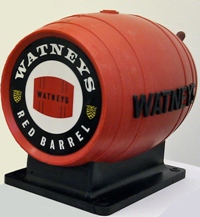
Closed brewery
Lower Richmond Road SW14 7ET (Richmond upon Thames)
First sold beer: 1641
Ceased brewing: December 2015
See also the entry for the current Watneys Beer.
This riverside brewery in Mortlake was the last working remnant of old school big brewing left in London before it closed in 2015. Its roots date back to a medieval monastery and a 15th-century manor house with a domestic brewery. By 1765, there were two small commercial outfits that later merged as the Star brewery, which in the 19th century became More & Co. But perhaps its best-known owner was Watney, which bought the site in 1889 as part of an ambitious expansion policy.
The new owner was founded by James Watney in 1858 at the original Stag brewery at the west end of Victoria Street in what was then known as Pimlico, to the south of the Royal Parks and Buckingham Palace and close to the future site of Victoria station, which opened two years later. It’s likely the Stag originated as a domestic brewhouse attached to St James’s Palace on the other side of the park. Commercial brewing began under William Greene in 1641. In 1898, less than a decade after adding the Mortlake facility, Watney became a major London force by taking on and closing Combe & Co in Long Acre, Covent Garden, and Reid’s Griffin brewery in Clerkenwell to form Watney Combe & Reid. It continued to develop both its sites in the 20th century and by the 1930s, it was so successful its share prices were included in the FT 30 index of leading UK companies.
In 1931, Mortlake became one of the first UK breweries to experiment with pasteurised keg ale, producing the first versions of a beer called Red Barrel for the export market. Through the 1950s and 1960s, the company pursued a ruthless programme of buying up and closing regional breweries, acquiring an estate of around 6,000 pubs through which it increasingly pushed its own generic keg products.
In 1959, the central London site was closed to make way for a traffic gyratory system, and Mortlake became the main brewery, inheriting the Stag name. Red Barrel evolved into the flagship brand, originally promoted as a premium product sold aboard luxury liners like the Queen Elizabeth II. But it gradually came to symbolise all that had gone wrong with British brewing in the era of the Big Seven, and the replacement of local distinctiveness and character with homogenous, bland, mass-produced, overpriced and heavily promoted national brands.
In the early 1970s, Watney was the subject of a bitterly-fought hostile takeover bid by the Grand Metropolitan hotel group, and tried to strengthen and protect itself by attempting to buy London’s last surviving major independent, Truman’s. But instead Grand Met took Truman’s and, in 1972, Watney as well, merging them to create Watney Mann Truman. Mann was closed in 1979, and Truman’s in 1989, as Grand Met gradually withdrew from brewing, selling its remaining plants to Courage, which in turn was ultimately absorbed by Heineken.
In 1991, Courage leased the Stag to US giant Anheuser Busch of St Louis, Missouri, and it was adapted to brew ‘American’ Budweiser in bottle and keg for the European market. AB bought the site outright in 2002, and it 2008 was bought out itself by Belgian-Brazilian group AmBev to become part of the newly-formed ‘world’s biggest brewer’ Anheuser Busch InBev (AB InBev or ABI). With several other facilities in Europe at its disposal, ABI was soon planning to close the Stag, though it was reprieved several times due to the high demand for Budweiser, before finally ceasing to brew at the end of 2015.
Following a period of decommissioning, ABI vacated the Stag during 2016. It’s now owned by a Singapore-based developer and is destined for regeneration as a new mixed-use neighbourhood of flats, shops and offices, with some of the historic buildings conserved. Though the brewery’s principal product in its latter days was likely of little interest to most readers of this website, it’s a considerable loss to London brewing heritage. A local campaign, the Mortlake Brewery Community Group, is trying to ensure that among other things the redevelopment sufficiently reflects the heritage of the site.
Meanwhile, all traces of the Stag at Pimlico have been obliterated. A new Stag pub in brutalist concrete was part of the late 1950s redevelopment scheme but has since been demolished for a further, more upmarket regeneration which includes the Nova building, named the UK’s ugliest building in 2017. The hind statue that once stood in front of the brewery offices now graces a Maidenhead shopping centre. But in this post-modern world anything is possible and in 2016 a new company leased the once-toxic Watneys brand from Heineken and revived brewing on a contract basis with new recipes. The Mortlake Stag’s last owner ABI retains a brewing presence in London through Camden Town Brewery and the Goose Island Brewpub.
Last updated 4 January 2020





The Stag statue is in Maidstone, not Maidenhead. Doubtful whether anyone knows its significance.